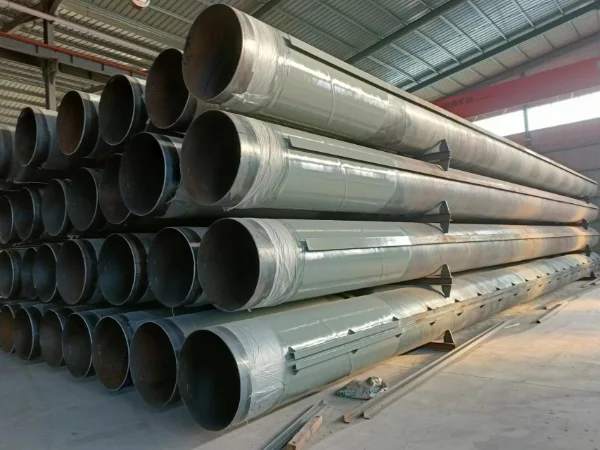The Importance of Steel Pipe Testing and Inspection
As a common building material, steel pipes are widely used in construction, bridges, pipelines, and other fields. Steel pipe is an essential component of many industries, including construction, oil and gas, and manufacturing. They are used to convey fluids and gases, provide structural support, and serve as conduits for electrical wires. However, due to the influence of various factors during the use of steel pipes, such as oxidation, corrosion, wear, etc., it will lead to a decline in quality and even hidden safety hazards. Therefore, detection is of great significance. In this article, we will explore the importance of steel pipe inspection and inspection, including non-destructive testing methods and quality control measures.

First of all, an inspection can ensure the quality of steel pipes. The process of production, transportation, and installation, may be affected by various factors, such as temperature, humidity, vibration, etc., which may cause quality problems. Through testing, these problems can be found and eliminated in time to ensure that the quality meets the standard requirements.
Secondly, steel pipe inspection can improve the quality of construction projects. In construction engineering, steel pipe is an important supporting material, and its quality directly affects the quality and safety of the entire project. Through the test, problems can be found in time, avoid safety hazards in the project, and improve the quality and safety of the project.
Again, steel pipe inspection can save costs. In construction projects, if there is a quality problem, it needs to be replaced or repaired in time, otherwise, it will cause project delays and additional costs. Through detection, problems can be found in time to avoid unnecessary costs and waste.
Finally, steel pipe inspection can improve the credibility of the enterprise. The occurrence of steel pipe quality problems will bring huge losses to the enterprise, which will not only affect the reputation of the enterprise but also affect the economic benefits of the enterprise. Through testing, it can ensure that the quality meets the standard requirements, improve the credibility of the enterprise, and enhance the competitiveness of the enterprise.
The following will introduce several common steel pipe inspection methods:
One of the most common methods of inspecting steel pipes is non-destructive testing (NDT). NDT is a technique that allows the detection of defects and imperfections in materials without damaging or destroying them. There are several types of non-destructive testing methods that can be used to inspect steel pipes, including ultrasonic testing, magnetic particle testing, and radiographic testing. Each method has its own advantages and limitations, and the choice of method will depend on the specific requirements of the application. Ultrasonic testing is a method that uses the characteristics of ultrasonic waves propagating in materials to detect internal defects in materials. By applying ultrasonic waves on the surface of the steel pipe, observe the propagation of the ultrasonic waves inside the steel pipe, so as to find internal defects such as cracks, pores, and inclusions. This method is suitable for detecting large internal defects; magnetic particle testing is a non-destructive testing method, by coating the surface with magnetic powder, and then applying a magnetic field at both ends to observe the distribution of the magnetic powder, so as to find cracks on the surface of the steel pipe, scars and other defects. This method is suitable for detecting steel pipes with deep surface cracks or small internal defects; ray inspection uses the characteristics of rays penetrating objects to judge the internal defects and quality of steel pipes by detecting the absorption, scattering, and transmission of rays. Professional equipment and technical personnel are required to operate, and safety needs to be paid attention to during the operation to avoid radiation damage to the human body. The results of the radiographic inspection can visually show the internal defects and quality status of the steel pipe, which provides an important basis for the quality control of the steel pipe.
In addition to non-destructive testing, quality control measures are also essential to ensure the quality and safety of steel pipes. Quality control measures include visual inspection, dimensional inspection, and material testing. Visual inspection includes checking for any defects or irregularities in the surface of the pipe, while dimensional inspection ensures that the pipe meets the required specifications. Material testing involves analyzing the chemical composition and mechanical properties of steel to ensure it meets the required standards.
The pressure test is also a method to test the pressure resistance of steel pipes. Fill the steel pipe with water or other liquids, and then apply a certain pressure to observe whether there is leakage or deformation. This method is suitable for testing whether the withstand voltage performance meets the standard requirements.
To sum up, the inspection and inspection of steel pipes is crucial to ensure their quality and safety. Non-destructive testing methods and quality control measures are critical to identifying flaws and weaknesses in steel pipes before they become a problem. By implementing these measures, we can ensure the reliable and safe use of steel pipes in various applications.
Related news of steel pipe
The Future of Steel Pipes and Pipe Fittings
The Importance of Proper Steel Pipe Maintenance
Choosing the Right Steel Pipe for Your Project: Tips and Considerations
The Advantages of Steel Pipes in Construction: Durability, Strength, and Versatility






